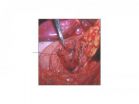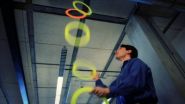(Press-News.org) Researchers at Washington University School of Medicine in St. Louis have demonstrated a new approach to treating muscular dystrophy. Mice with a form of this muscle-weakening disease showed improved strength and heart function when treated with nanoparticles loaded with rapamycin, an immunosuppressive drug recently found to improve recycling of cellular waste.
The study appears online in The FASEB Journal.
The investigators, including first author Kristin P. Bibee, MD, PhD, looked at a mouse model of Duchenne muscular dystrophy, the most severe inherited form of the disease. Duchenne exclusively affects boys who have to rely on wheelchairs by age 12 and die from heart or respiratory failure in their 20s.
The faulty gene that causes the disease prevents the body from producing dystrophin, a protein crucial for maintaining muscle cell integrity and function. The new study demonstrated that mice with muscular dystrophy, in addition to missing dystrophin, also can't recycle cellular waste, a process known as autophagy, or self-eating.
"Autophagy plays a major role in disposing of cellular debris," said senior author Samuel A. Wickline, MD, the James R. Hornsby Family Professor of Medicine. "If it doesn't happen, you might say the cell chokes on its own refuse. In muscular dystrophy, defective autophagy is not necessarily a primary source of muscle weakness, but it clearly becomes a problem over time. If you solve that, you can help the situation by maintaining more normal cellular function."
Though it's not clear how the missing dystrophin protein might be responsible for the muscle cells' poor housekeeping, the study showed that boosting autophagy improved skeletal muscle strength and heart function in these mice.
"Some investigators are looking for ways to replace dystrophin," said co-author Conrad C. Weihl, MD, PhD, associate professor of neurology. "But here we are focusing on the defect in autophagy. What is exciting about our approach is that there are existing drugs that activate autophagy. And by repackaging the drug on nanoparticles, we can target it specifically to muscles and correct the defect in the cells' ability to recycle waste."
When treated with rapamycin nanoparticles, the mice showed a 30 percent increase in grip strength and a significant improvement in cardiac function, based on an increase in the volume of blood the heart pumped.
"An important aspect of our study is that we are treating both skeletal muscle and heart muscle with the same drug," Wickline said. "The heart is a difficult organ to treat in muscular dystrophy. But even in older animals, this regimen works well to recover heart function, and it is effective over a short period of time and after only a few doses."
"Death from Duchenne in many people is due to heart dysfunction," said Weihl, who also treats patients with neuromuscular disorders at Barnes-Jewish Hospital. "So even improving cardiac function by 10 percent in late-stage disease could be very important."
The nanoparticle used in the study consists of an inert core made of perfluorocarbon, originally designed as a blood substitute. The particles are about 200 nanometers in diameter—500 times smaller than the thickness of a human hair. The surface of the nanoparticle is coated with rapamycin, which suppresses the immune system. The drug typically is used to help prevent organ rejection in transplant patients. It is known for its anti-inflammatory properties and, more recently, for its role in activating autophagy.
When injected into the bloodstream, according to Wickline, the nanoparticles accumulate in areas of inflammation, where damaged tissues have leaky blood vessels and are undergoing cell death and repair.
"The nanoparticles tend to penetrate and be retained in areas of inflammation," Wickline said. "Then they release the rapamycin over a period of time, so the drug itself can permeate the muscle tissue."
Compared with oral delivery, the nanoparticle approach also allowed the researchers to give the mice smaller doses of the drug.
"We showed that oral doses of rapamycin, even at 10 times the dose we used in the nanoparticles, were ineffective," Weihl said. "This is important because rapamycin suppresses the immune system, and directly targeting it to muscle in smaller doses would reduce unwanted side effects."
Current treatment for Duchenne involves corticosteroids such as prednisone, which has been shown to extend the time patients are able to walk. But steroids also cause weight gain, brittle bones, high blood pressure and other long-term side effects.
Although it's not clear why steroid treatment helps maintain skeletal muscle strength, Weihl said the study suggests prednisone also may promote autophagy, raising the possibility of combination therapy, in which both steroid treatment and rapamycin nanoparticles could be given simultaneously, each at lower doses.
INFORMATION:
This work was supported by the National Institutes of Health (NIH) grants R01 AR056223, HL073646, HL112518, HL113392, NS073457ß, K02 AG042095, the Muscular Dystrophy Association, and the American Heart Association.
Bibee KP, Cheng YJ, Ching JK, Marsh JN, Li AJ, Keeling RM, Connolly AM, Golumbek PT, Myerson JW, Hu G, Chen J, Shannon WD, Lanza GM, Weihl CC, Wickline SA. Rapamycin nanoparticles target defective autophagy in muscular dystrophy to enhance both strength and cardiac function. The FASEB Journal. Online Feb. 5, 2013.
Washington University School of Medicine's 2,100 employed and volunteer faculty physicians also are the medical staff of Barnes-Jewish and St. Louis Children's hospitals. The School of Medicine is one of the leading medical research, teaching and patient-care institutions in the nation, currently ranked sixth in the nation by U.S. News & World Report. Through its affiliations with Barnes-Jewish and St. Louis Children's hospitals, the School of Medicine is linked to BJC HealthCare.
Nanoparticles treat muscular dystrophy in mice
2014-02-11
ELSE PRESS RELEASES FROM THIS DATE:
Child abuse rises with income inequality, study shows
2014-02-11
ITHACA, N.Y. – As the Great Recession deepened and income inequality became more pronounced, county-by-county rates of child maltreatment – from sexual, physical and emotional abuse to traumatic brain injuries and death – worsened, according to a nationwide study by Cornell University.
The income inequality-child maltreatment study, to be published in the March 2014 edition of the peer-review journal Pediatrics, covers all 3,142 American counties from 2005-09, and is one of the most comprehensive of its kind and the first to target child abuse in places with the greatest ...
I smoke, but I'm not a smoker
2014-02-11
While smoking among California adults has dramatically declined in recent decades, researchers at the University of California, San Diego School of Medicine report there is a surprisingly large number of people who say they use cigarettes, but don't consider themselves to be "smokers."
Writing in the February 5 online issue of Tobacco Control, Wael K. Al-Delaimy, MD, PhD, professor and chief of the Division of Global Health in the UC San Diego Department of Family and Preventive Medicine, and colleagues estimate that, in 2011, almost 396,000 Californians (12.3 percent ...
Dartmouth study provides first global evidence that foreign aid boosts public opinion
2014-02-11
A study by Dartmouth and Australian researchers provides the first empirical evidence using data from a variety of countries that foreign aid can greatly improve foreign public opinion of donor countries.
The findings are based on a U.S. foreign aid program targeting HIV and AIDS -- the President's Emergency Plan for AIDS Relief (PEPFAR) -- that has substantially improved public perception of the United States in the more than 80 developing countries receiving the aid. But the findings have broader policy implications for an emerging international order in which major ...
Game changer: Biomarker identified for noncancerous pancreatic cysts
2014-02-11
INDIANAPOLIS -- Researchers at the Indiana University School of Medicine have discovered a highly accurate, noninvasive test to identify benign pancreatic cysts, which could spare patients years of nerve-racking trips to the doctor or potentially dangerous surgery.
The findings are reported in "Vascular Endothelial Growth Factor, a Novel and Highly Accurate Pancreatic Fluid Biomarker for Serous Pancreatic Cysts" online in the Journal of the American College of Surgeons.
The test, which analyzes fluid from pancreatic cysts, can identify a common type of benign cyst that ...
New target isolated for leukemia drug development
2014-02-11
SAN ANTONIO (February 11, 2014) – There are potentially effective treatments for acute myeloid leukemia (AML), but they only work in 20 to 40 percent of cases. In a paper published today in Leukemia, a Nature journal, a UT Health Science Center researcher has pinpointed a protein that could play a key, previously unknown role in the development of pediatric AML — promising new information in the quest to treat and cure childhood leukemias.
AML starts at the point when cells mature into different kinds of blood cells. In AML, the cancerous cells grow and proliferate in ...
No clowning around: Juggling sheds light on how we run
2014-02-11
Juggling may seem like mere entertainment, but a study led by Johns Hopkins engineers used this circus skill to gather critical clues about how vision and the sense of touch help control the way humans and animals move their limbs in a repetitive way, such as in running. The findings eventually may aid in the treatment of people with neurological diseases and could lead to prosthetic limbs and robots that move more efficiently.
The study was published online recently by the Journal of Neurophysiology and will be the cover article in the journal's March 2014 print edition.
In ...
EU rules are denying children latest cancer drugs
2014-02-11
Children with cancer are being denied new, potentially life-saving drugs, because EU rules are allowing companies to trial some drugs only in adults, leading cancer experts warn today.
Changes to how EU rules are implemented could allow children access to a goldmine of potential cancer drugs which have currently only been tested in adults – by making it more difficult for pharma companies to avoid testing them in under-18s too.
Under the current system, pharma companies often gain exemptions from carrying out expensive testing of cancer drugs in patients under the age ...
Heart attack research discovers new treatment target
2014-02-11
New Orleans, LA – Research led by David Lefer, PhD, Professor and Director of the Cardiovascular Center of Excellence at LSU Health Sciences Center New Orleans School of Medicine, demonstrates for the first time cross-talk between two protective signaling molecules during a heart attack. By providing new and important information about the mechanisms involved in heart attacks and organ transplantation, the research identifies a potential new treatment target for heart disease. The paper will be published in Proceedings of the National Academy of Sciences (PNAS) Online Early ...
Point-of-care ultrasound for suspected appendicitis in kids proves accurate
2014-02-11
New York, NY – Using portable ultrasound as a first-line imaging study in kids with suspected appendicitis helps reduce emergency room length of stay and reduces the need for CT scans, according to a team of Mount Sinai researchers. Bedside ultrasound, often referred to as point-of-care ultrasonography, has a specificity of about 94%, meaning that it misses few cases, , the Mt. Sinai researchers add. Results from the study are published online February 10 in the peer-reviewed journal Academic Emergency Medicine.
"From an institutional perspective, this is the most common ...
ASTRO and SSO issue consensus guideline on margins for breast-conserving surgery with WBI
2014-02-11
Fairfax, Va., February 10, 2014 – The American Society for Radiation Oncology (ASTRO) and the Society of Surgical Oncology (SSO) are pleased to announce the publication of the consensus guideline on margins for breast-conserving surgery with whole-breast irradiation in stages I and II invasive breast cancer. The guideline document represents an intensive collaboration among experts in the radiation oncology and surgical oncology fields, led by Meena S. Moran, MD, associate professor of the Department of Therapeutic Radiology at Yale School of Medicine in New Haven, Conn., ...




